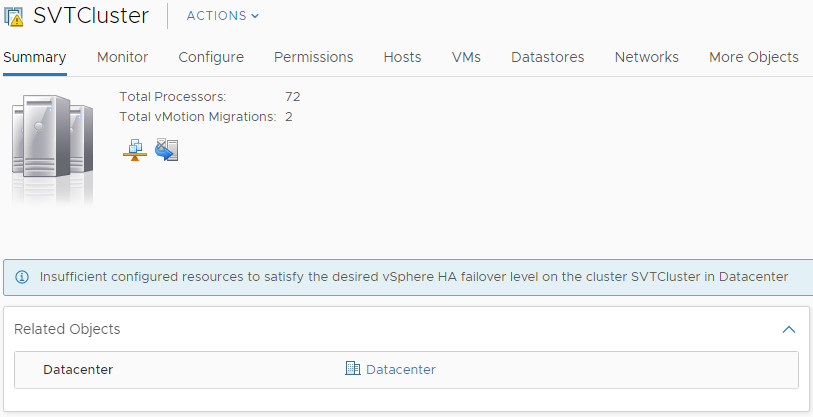The article delves into the critical issue of "insufficient resources to satisfy configured failover level for vSphere HA." Addressing this issue involves a comprehensive understanding of HA configurations, proactive resource management, then refer to the following information.

This issue arises when the High Availability (HA) configuration for CPU or memory resources, reserved for failover, is not meeting the requirements for Distributed Resource Scheduler (DRS) operations. The message suggests that there may not be enough resources to restart all virtual machines in case of a host failure. This could be due to a strict admission control setting on the cluster.
For example, in a 4-host environment, a single host would equal 25%. In some cases, customers would set the percentage to a value lower than 25%. It's needed to verify the configured percentage if you set it manually. Ensure that at a minimum it equals the largest host in the cluster.

The alarms have options to Acknowledge or Reset. However, this is a message indicating a configuration issue instead.
✍ To solve the insufficient vSphere HA failover resources
1. Turn on, or turn off Proactive HA and then disable HA on the cluster, then re-enable HA
2. Verify no firewall is interfering with HA
3. Set Admission Control percentage to a different, low value (10% CPU/Memory)

4. Browse to the vSphere HA cluster, then click Configure tap.
5. Select vSphere Availability > Edit.
6. Click Admission Control to display the configuration options.
7. Refresh the vSphere client, and the error should disappear
The available resources in this cluster are not enough to allow failover to operate for all running VMs. You need an effective backup software for VMware vSphere to protect your virtual environment and gain the ability to quickly recover your virtual machines when needed. This part will offer an efficient VMware vSphere backup software- AOMEI Cyber Backup, which enables you to backup multiple VMs either managed by vCenter Server, or on a standalone ESXi host.
It simplifies the backup process and present the steps with intuitive GUI interface. In addition, it offers you the following benefits.
✦ Agentless Backup: create complete and independent image-level backup for VMware ESXi and Hyper-V VMs. ✦ Support Free ESXi: AOMEI Cyber Backup support both paid and free versions of VMware ESXi. ✦ Flexible vSphere Backup: batch backup large numbers of VMs managed by vCenter Server, or multiple VMs on a standalone ESXi host. ✦ Multiple Storage Destinations: backup to local drive, or network destinations like Windows share or NAS. ✦ Automated Execution: create backup schedules to automate backups daily, weekly, monthly. ✦ Email Notification: send email notification when the task is completed or abnormal. ✦ Role Assignment: allows one administrator to create sub-accounts with limited privileges.
As for VMware vSphere, AOMEI Cyber Backup supports VMware ESXi 6.0 and later versions. Next, I will show you how to perform vSphere VM backup and restore via AOMEI Cyber Backup. You can click the following button to download the free trial.
📢 Steps to perform vSphere backup via AOMEI Cyber Backup
1. Bind Devices: Access to AOMEI Cyber Backup web client, navigate to Source Device>VMware>+ Add VMware Device to Add vCenter or Standalone ESXi host. And then click…>Bind Device.
2. Create Backup Task: Navigate to Backup Task>+ Create New Task, and select VMware ESXi Backup as the Backup Type.
3. Set the Task Name, Device, Target, Schedule and Cleanup as needed.
4. Run Backup: Now you can click Start Backup and select Add the schedule and start backup now, or Add the schedule only.
Created backup tasks will be listed and monitored separately for restoring, progress checking and schedule changing.
▶ Restore to new location: Create a new VM in the same or another datastore/host directly from the backup to perform out-of-spacre recovery, saves the trouble of re-configuring the new VM.
Understanding and addressing the issue of "insufficient vSphere HA failover resources" is crucial for maintaining the reliability and stability of virtualized environments. By acknowledging the potential challenges associated with resource inadequacy during failover events, administrators can proactively configure and optimize their vSphere HA settings. This involves ensuring an adequate allocation of CPU and memory resources, fine-tuning failover levels, and adopting best practices for resource management. A well-configured vSphere HA environment not only mitigates the risk of service disruptions but also contributes to the overall resilience and efficiency of the virtualized infrastructure.